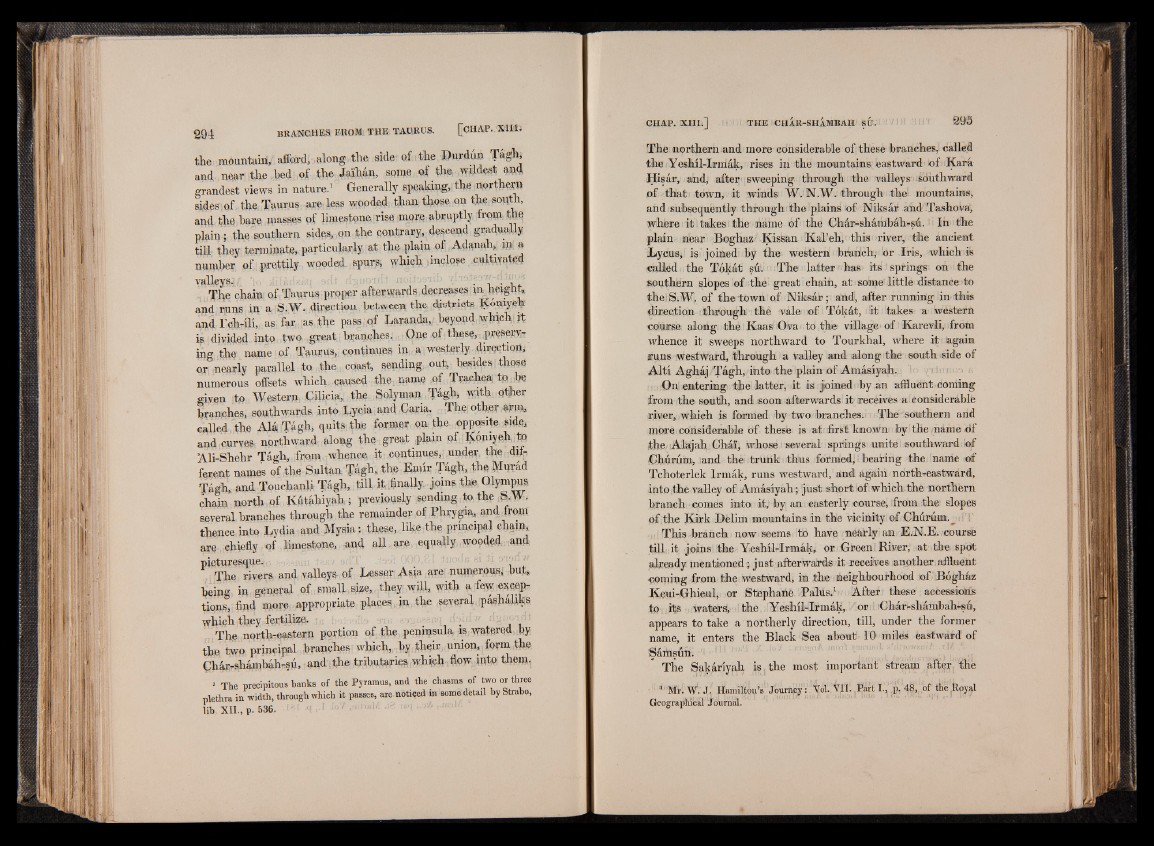
the mountain, affardj along the side of the Durdun Taigh,
and near the bed of the Jaihan, some of the wildest and
grandest views in nature.1 Generally speaking, the northern
sides' of the Taurus- are- less wooded than tlmse on the. south,
and the hare masses of limestone, rise more abruptly from the
plain; the southern sides, on the contrary, defend gradually
till they terminate, particularly at 1 the plain o f , Adanah, m ft
number of prettily wooded spurs, which inclose cultivated
ysdleys,.*/; lo ‘ jkftidaki odi dgpotjH Mh&jgg v
The chain of. Taurus proper afterwards decreases m height.,
and runs in a -S.W. direction between the districts Kdmyeh
and l ’oh-ili,. as far, as the pass of Laranda, beyond winch it
is jdivided into two great branches, One of tlmse, preserving
the name | of Taurus, continues in awesterlydirection,
or nearly parallel to the coast, sending out, brides those
numerous offsets which caused the name of Trachea to 1«?
given to Western Cilicia,, the fdolyman /lYigh, with.,other
branches, southwards into Ly<;ia and (Jana. The other arm,
called the Ala; Tag11* quits; th© former on the opposite side,
and curves northward along the great plain of: Kopiy elu hi
Ali-Shehr Tagh, from whence it continues, under the dlG
feient names of the Sultan Tagh, the Emir Tagh,. 4iift Murad
Tdgh, and Touchanli Tag1» , i t finally joins the Olympus.
«»hniii,north, o f , Kutfthiyah,; previously sending to the ,KW.
several branches through the remainder of l ’hrygia, and from
thence into Lydia and Mysia:- these, like the prm.ctpal chain,
are chiefly of limestone, and all are equally wooded, and
picturesque. - 000,1 tnodfi si
The riyers and valleys of Lesser Asia are; rLUinerousi put,
being in general of small,size, they will, with a few e^qqp-
tions, find more appropriate places,.in, the several pashal.iks
which they .fertilize. - -. asnq rfoidw ;
The north-eastern portion of the peninsula is watered py
the two principal branches which, by their union,, form the
Char-shamhah-sii, and the tributaries which flow, into them,
1 The precipitous banks of the Pyramus, and the chasms of two or three
plethra in width, through which it passes, are noticed in some detail by Strabo,
lib, XII., p. 536.
The northern and more considerable of these branches, called
the Yeshil-Inriak, rises in the mountains eastward o f Kara
Hisâr, and, after sweeping through the valleys ;sÜiithward
of that town, it winds W.-N.W. through the mountains,
and, subsequently through the plains of Niksâr and Ta.shova,
where it takes the name of the Châr-shambâh-su. li In the
plain- near Boghaz' .Kissan KaTeh, this river, the ancient
Lycus, is joined by the western branch, or Iris, which is
called the Tokat suv The latter has its ! springs on the
southern slopes o f the great chain, at some: little distance to
iheiS;Wf of the town of Niksâr; and, after running‘in this
direction through thé vale : of : Tokât, it takes a western
course along the Kaas;Ova- to the village of Karevii, -from
whence it sweeps northward to Tourkhal, where .it again
runs westward, through a valley and along the south side of
Alti Aghaj -Tagh, into the plain of Amasiyah.
On entering the! latter, it is joined by an affluent-coming
from the south, and soon afterwards it receives a considerable
river, which is formed by two branches. The southern and
more considerable of these is at first known by the name <if
the Alajah Ghâï, whose 1 several springs unite southward ; lof
OMrjutej ¡and the trunk thus formed, bearing the name o f
Tchoterlek lrmak, runs westward, and. again north-eastward,
into the valley of Amâsiyah ; just short of which the northern
branch comes into it, by an easterly course, from the slopes
of the Kitk Delim mountains in the vicinity of, Churdrn. :
Thi^.-branch now seems tb have nearly an E.N.K .course
till it joins the Y.eshil-Irmak, or Green River,: at the spoct
already mentioned ; just afterwards it receives another affluent
•coming from the westward, in the neighbourhood of Boghaz
Keui-Ghieul, or Stéphane PaldsA. - After these accessions
to fts waters, the Yeshil-Irmak, or ¡Ghâr-sliâmbah-su,
appears to take a northerly direction, till, under the former
name, it enters the Black Sea about 10 miles eastward of
Sâmsiin.
The Sakariyah is-the most important stream after the
1 Mr. W. J. Hamilton's Journey: Vol. VII. l ’art T., p. 48, of the jlovat
Geographical Journal.